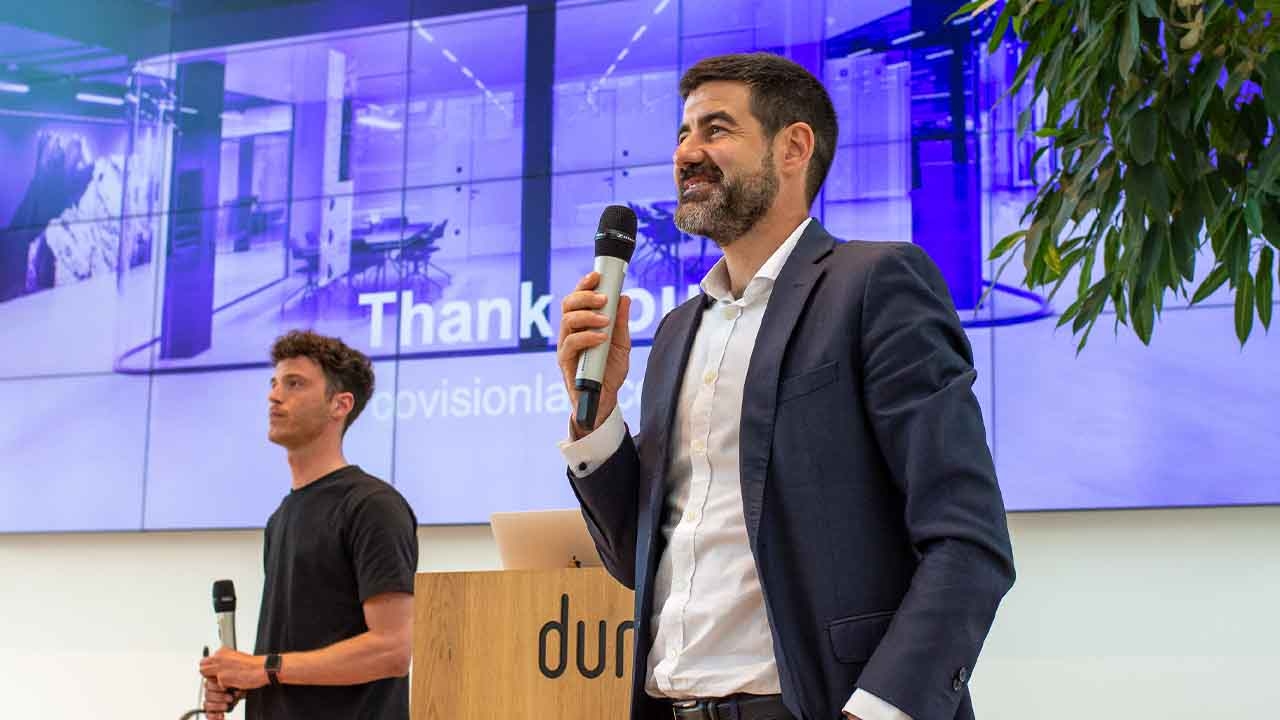Durst Beyond event envisions the future of digital print
A new automated print quality inspection system and UV ink series were key highlights from Durst’s customer event held at the company’s Brixen HQ

Durst used its recent open-house and conference event to introduce a radical new automated quality control system
called Hawk Eye, which will be officially launched at Labelexpo Europe 2023.
Durst Hawk Eye uses camera vision systems to automate print quality on-the-fly, resulting in significantly reduced waste and overall improved print quality, according to Martin Leitner, product manager, labels and flexible packaging at Durst. The technology will be standard on all new presses and retrofittable on all RSC presses installed since 2018.
Comments Leitner: ‘Durst is seeking to drive performance of its Tau RSC presses further with a new technology that automates quality on-the-fly, bringing the possibility of waste and setup reduction and operator time savings.’
Held at its headquarters in Brixen, Italy, the three-day Durst Beyond event showcased the company’s latest printing, ink and software technologies, including both Hawk Eye and a new generation of UV inkjet inks. Additionally, round-table discussions and presentations provided insight to help label and packaging printers succeed when faced with rapid technological and
demographic change, in an increasingly regulated supply chain where sustainability, speed and quality matter.
Process automation has been a dominant industry topic for perhaps a generation. Generally, the benefits of this have been framed in terms of waste reduction and repeatable quality, but now digitization is seen as essential for long-term corporate survival. Demographic changes will mean chronic labor shortages, so label and packaging converters must start planning to reduce human intervention and rely more on computerized technologies.
With that in mind, people and planet were the two defining issues of the conference. ‘People are critical for our industry, yet human resources are increasingly a challenge,’ says Thomas Macina, global sales director, labels and flexible packaging. ‘How do we find people, train them, keep them motivated, how to retain them? How to ideally depend on fewer stakeholders who can take decisions and train machines to perform.’
UV ink developments
The digital press is only one element of a productive, reliable digital workflow. Efficient data handling, color matching, ink certification and performance, quality control systems and training are also vital elements of the workflow. Durst manufactures its inks and software for its presses, these are the essential cornerstones of a high-performance printing system, and the focus of innovation.
Stefan Kappaun, executive vice president of inks and fluids at Durst Group, highlighted the strong growth prospects for UV inks in the label printing market of between 8-10 percent a year, given their versatility, light-fastness, fast curing, chemical and temperature resistance, and compatibility with different substrates
and analog pre/post-treatments.
Kappaun announced the latest developments in Durst’s UV inkjet ink program, with new environmental and safety certifications as well as a dedicated low-migration inks range for indirect food contact applications.
Without a doubt, we see the proliferation of SKUs, shorter lead times and the demand to eliminate obsolescence and inventory
Durst’s Tau RSC UV ink portfolio for its RSC label and packaging printing platforms comprises two sets: the ‘standard’ Tau RSC UV ink and the Tau RSC LM (low migration) Ink. The standard Tau RSC UV ink, available in CMYK, and optionally orange, violet, green and white, is suited for automotive, electronics, industrial, commercial printing, chemicals and personal care. The low migration ink, in CMYK and optional orange, blue and white, is designed for food, beverages, cosmetics, pharmaceuticals and toiletries. Covering 95 percent of the Pantone range with seven colors, both have Swiss Ordnance compliance while the LM inks are also compliant with the Nestlé exclusion list.
The inks are REACH, Toy Standard and Greenguard certified. Durst has also gained certification from the Association of Plastic Recyclers for its inks when used on pressure sensitive labels with HDPE or PET containers, showing that this ink and substrate combination works in the recycling process.
Software solutions simplify workflow
Michael Deflorian, business unit manager, software and solutions, explained Durst’s heavy investment in developing software technology to streamline the process from pixel to output. The Durst software and solutions business unit has more than 70 people dedicated to software, developing products in e-commerce, prepress and automation groups.
‘At the heart of the Durst offering is the press, the production environment. But automation is the key to feeding it efficiently,’ says Deflorian. ‘If you digitalize processes and customer touch points, then you get a lot of data. Data is key to understanding how to feed the machine in the most efficient way, and how to optimize processes.’
By going digital, we’ve been able to reduce finished inventory from USD 1M to under USD 700,000 and print on demand from e-commerce sites
The range of software includes Durst Smart Shop and Smart Editor software to support the development of an e-commerce business model, and Durst Workflow Label which automates prepress tasks and ripping; The Save Ink feature within DWL makes it easy to remove excess flood color areas outside the dieline of the label file, for example, with the potential to dramatically reduce the cost to print. The software provides estimates for ink consumption and ink cost, per color, for any file.
Durst’s software is optimized for integration with third-party ERP systems, such as commonly used platforms from Sage or Cerm.
Workflow analytics is a machine-related software, standard with the press. It provides live and historical performance data, helping the user stay informed about productivity, ink consumption, output levels and job status.
Additionally, with remote access, Durst service teams can
monitor the performance of the customer’s machine for early problem detection, such as the need to replace a filter.
Panel discussion highlights sustainability
During the Durst Beyond event, a panel discussion looked at changing business models with digital printing, emphasizing the challenges of meeting sustainability targets.
The brand perspective was provided by two representatives from Dr Schär, an international food and dietary supplements business headquartered in South Tyrol, Alexander Mayr, who leads the packaging artwork studio, and Davide Agnoli, global packaging project manager.
Agnoli noted that sustainability has broadened to include
targets for sustainable packaging, CO2 footprint, and diversity and inclusion at Dr Schär.
‘With sustainable packaging, we focus on three aspects: reduce, reuse, recycle,’ says Agnoli. ‘For the reuse part, we are trying to cut usage of plastic by 25 percent by the end 2024. With recycle, we are trying to achieve a transition to fully recycled materials by the end of 2024. Our partners and suppliers are working in that direction, developing solutions in terms of film that is easy to handle in different countries.’
Mayr is the point of contact for Dr Schär’s printing suppliers
around the world. He highlighted the difficulty of complying with global environmental regulations that often differ from country to country and change frequently. This means there is an ever-present risk of scrapping printed stock.
Mayr’s solution is more product regionalization, and lower
minimum order quantities. Switching from gravure or flexo to digital process for some products would make this possible.
Robert McJury, president of TLF Graphics, a label converter based in Rochester, New York, noted that brands are pushing suppliers for more sustainable packaging. But while surveys repeatedly reveal consumer concern about plastic packaging, switching to ‘ecofriendlier’ alternatives does not always result in increased sales.
An organic tomato grower customer of TLF switched to kraft
board, for example, but it proved less popular as the product was not visible.
McJury explained how adopting digital printing has helped TLF on its sustainability journey. Its two 13in Durst presses were installed in 2015 and 2018 and now account for 55 percent of the company’s revenue.
‘We’ve printed about 37,000 orders on our Durst presses. And while the obvious benefits like reduction of waste, labor and power consumption spring to mind, one of the interesting things is that we’ve eliminated 151,000 printing plates from going into the landfill,’ says McJury.
With substrate waste between jobs limited to approximately
two linear meters (6ft), the digital presses give TLF the agility to meet customer demands for shorter runs, increasingly on a just-in-time basis – although the company is regularly running jobs up to 90,000 linear feet (27,432m). McJury comments: ‘Without a doubt, we see the proliferation of SKUs, shorter lead times and the demand to eliminate obsolescence and inventory. By going digital,
we’ve been able to reduce finished inventory from USD 1M to under USD 700,000 and print on demand from e- commerce sites.’
Stay up to date
Subscribe to the free Label News newsletter and receive the latest content every week. We'll never share your email address.


